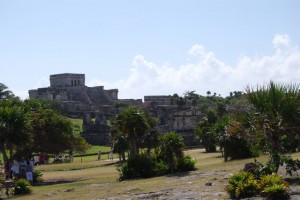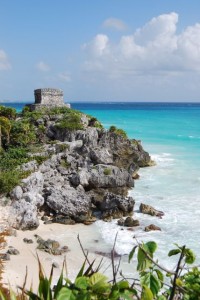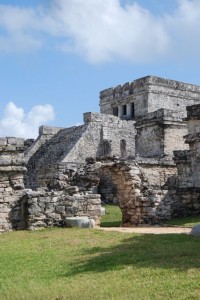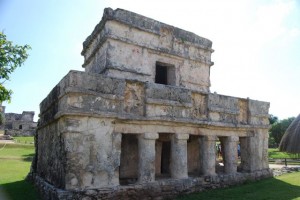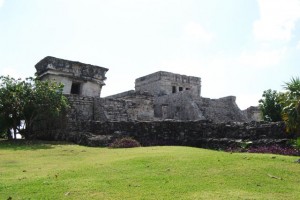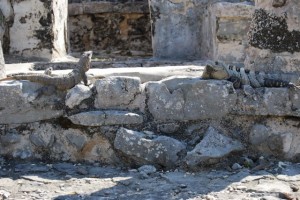The Ruins of Tulum Posted by sasha on May 21, 2012 in Uncategorized
From Valladolid and Ek Balam, we jumped back on the ADO bus bound for Tulum. It was a short and comfortable ride, as the public transportation of Mexico once again delivered. Arriving in Tulum in the evening, we made our way to our hostel in the town. While there are plenty of fantastic beach side resorts in Tulum, we opted for the more economical Mama’s Home, a quaint little hostel owned by a local family. With a nice, big private room, a delicious free breakfast, and bicycles for rent, it was a great base for exploring the area. We strolled along the main strip and grabbed some dinner and drinks before calling it an early night.
The next morning, we headed out on bikes to pay a visit to the ruins of Tulum. Located on the East Coast of the Yucatán, this is one of the best preserved cities of the Maya. Situated along the Caribbean Sea atop 12-meter (39 feet) tall cliffs, Tulum was a walled city that served as a major port for Cobá. Even after the Spanish occupation in Mexico, Tulum managed to survive for a solid 70 years or so. It’s believed that diseases brought by the Spanish colonists led to the demise of this great Maya city.
The name Tulum means “fence,” “wall,” or “trench” in Mayan, and the walls around the city helped to defend against invaders. With easy access to both sea and land routes, Tulum was also an important trading hub in Mayan civilization. These days, it’s an incredibly popular tourist destination, as busloads of tour groups show up daily from the neighboring resort cities of Cancun and Playa del Carmen. If you hope to beat the groups and the heat, it’s best to stay in Tulum and arrive at the ruins first thing in the morning.
Exploring the ancient city makes for a relaxing morning, as the site is not too big – it can comfortably be covered on foot in an hour or so. With the turquoise waters of the Caribbean and a white sandy beach as a backdrop, it’s certainly the most picturesque of the Mayan ruins in Mexico. Visitors are free to wander the grounds on their own accord, and knowledgeable tour guides are also available for hire.
Within the city walls are a number of impressive structures, all displaying the wonder of Mayan architecture and art. The main structure sits on the edge of the cliff overlooking the Sea. Known as “El Castillo” (the Castle), this most likely served as a landmark for sailors. It was originally covered in stucco and painted red, and it served as both a temple and a fortress. Standing beside the Castle, we were treated to magnificent views of the Caribbean, stretching out as far as the eyes could see. If you’re so inclined, you can even head down to the beach and take a dip.
Many carvings of the Mayan “diving god” or “descending god” can be found throughout the site, including above the doorway of the Temple of the Frescoes. This figure, which appears to have bird’s wings and a tail, is believed to represent a Mayan deity who protected the people. The temple was used by the Maya as an observatory for tracking the movements of the sun.
Another important structure at Tulum that depicts this figure is the “Templo del Dios Descendente” (Temple of the Descending God). If you’re curious as to why this figure is named the “Descending God,” it’s because he is always depicted with his feet in the air, as if he is descending from the sky. Inside of the temple are murals that depict both heaven and earth.
With stunning scenery, incredible architecture, and tons of history, Tulum should be high atop anyone’s list who is planning a trip to Mexico. In addition to the ruins of this ancient Mayan city, there’s plenty more to do in the area. It’s well developed for tourism, but not in excess (see Cancun and Playa del Carmen). In our two-week trip around the Mayan Riviera and the Yucatán, Tulum was hands down our favorite stop. With beautiful beaches, a variety of bars and restaurants, plenty of opportunities for fun in the water, and of course, the rich culture and history of the ruins, it really is hard to beat as a vacation destination.

Build vocabulary, practice pronunciation, and more with Transparent Language Online. Available anytime, anywhere, on any device.



